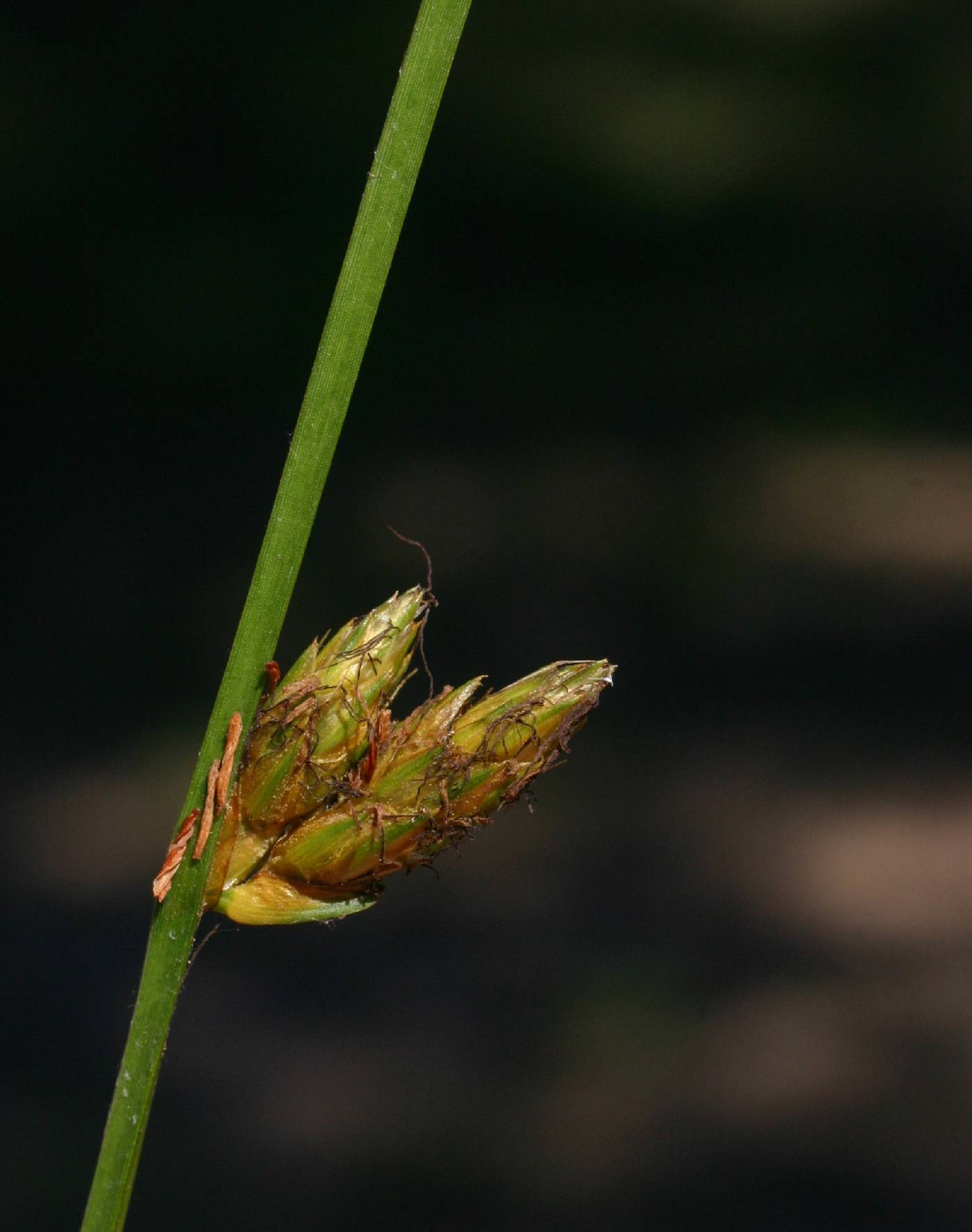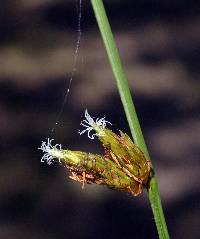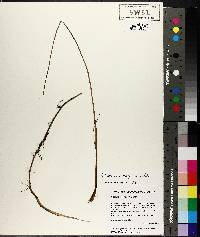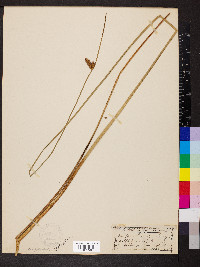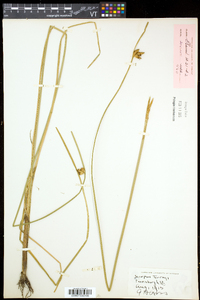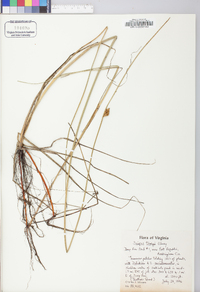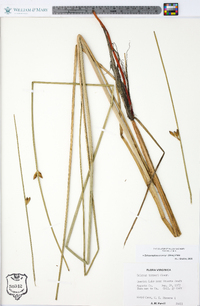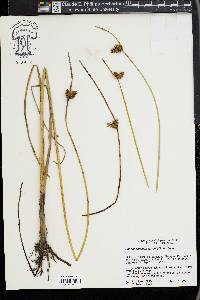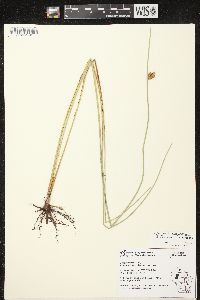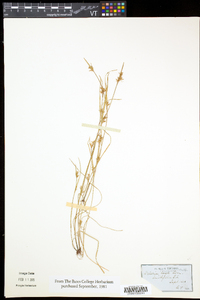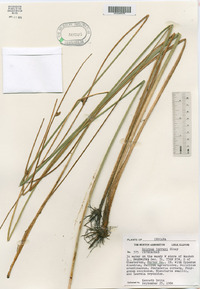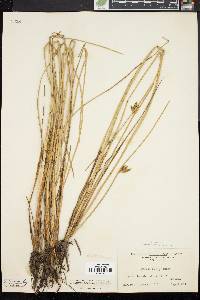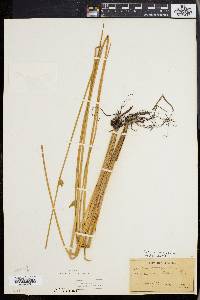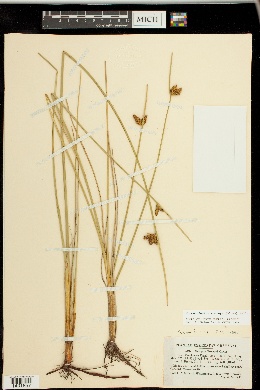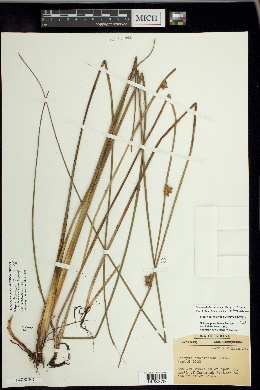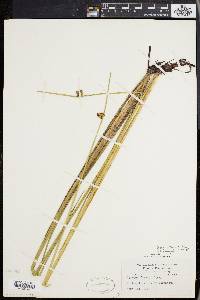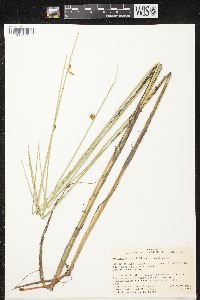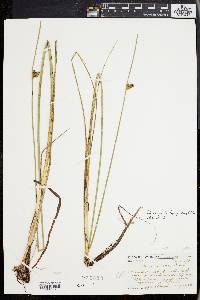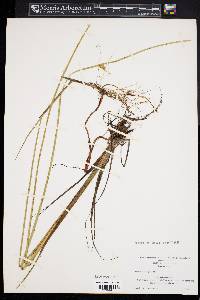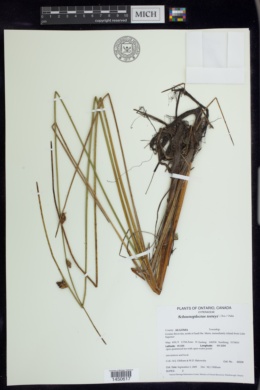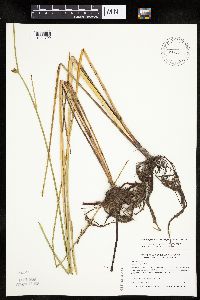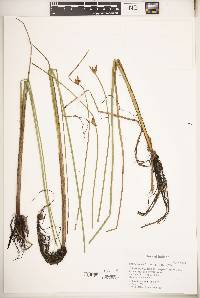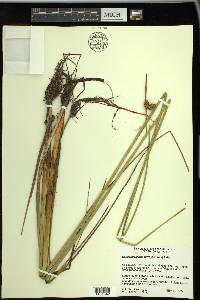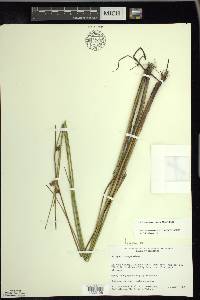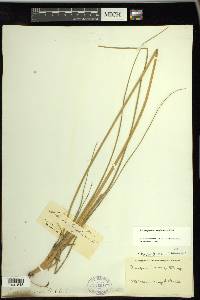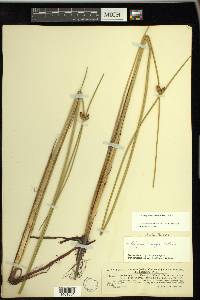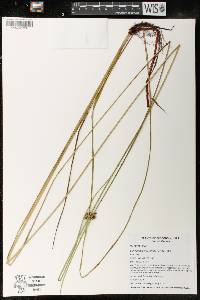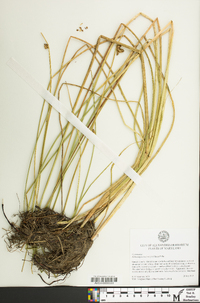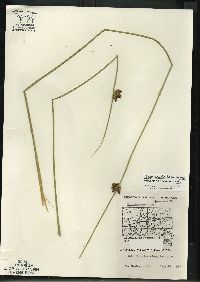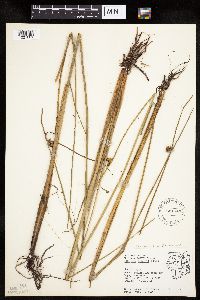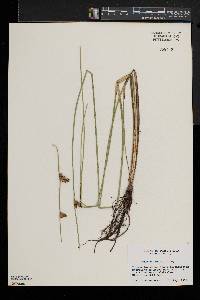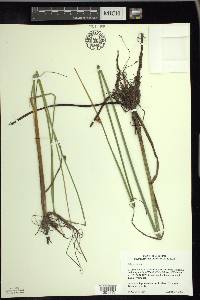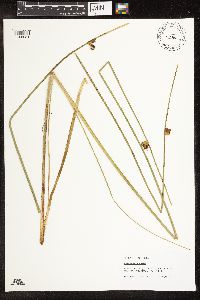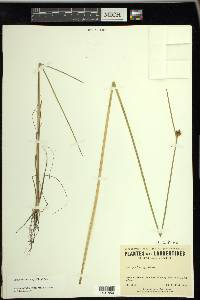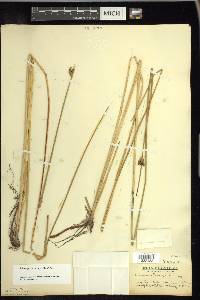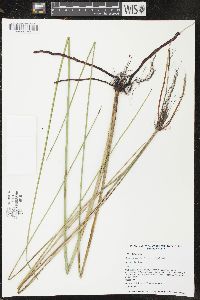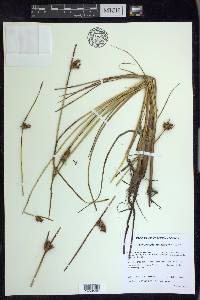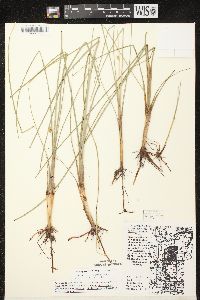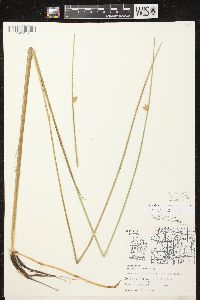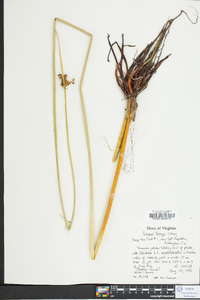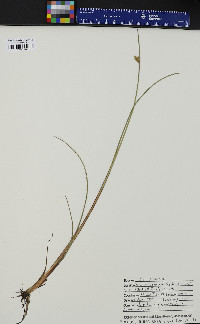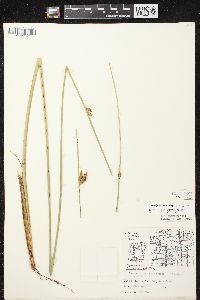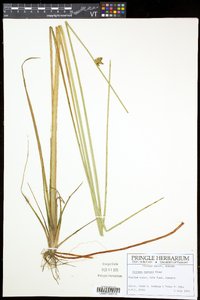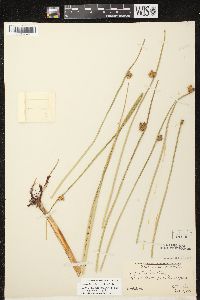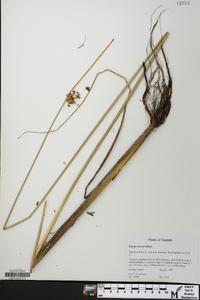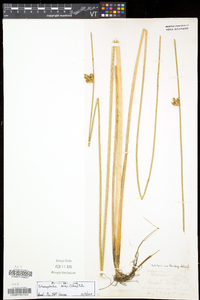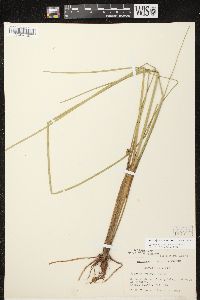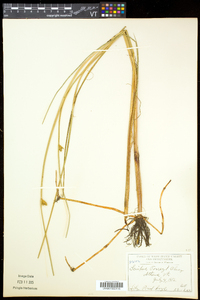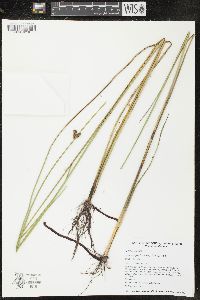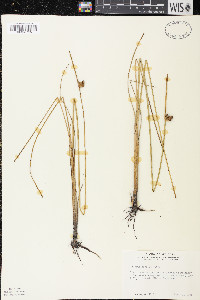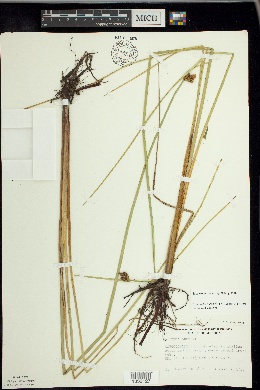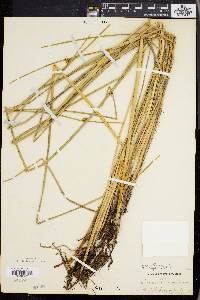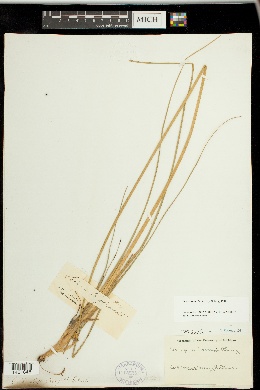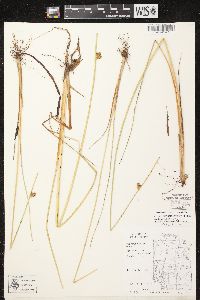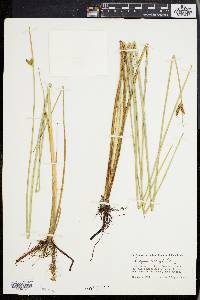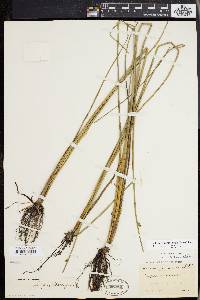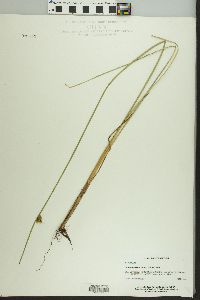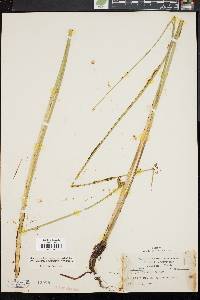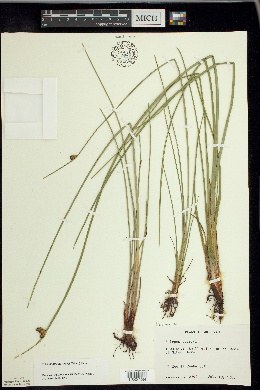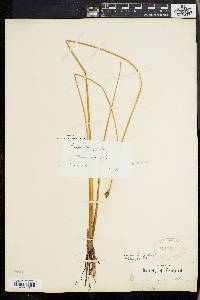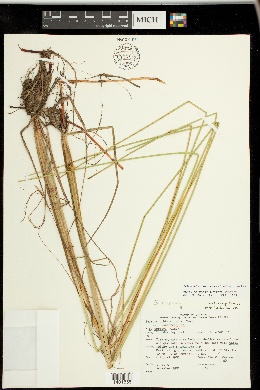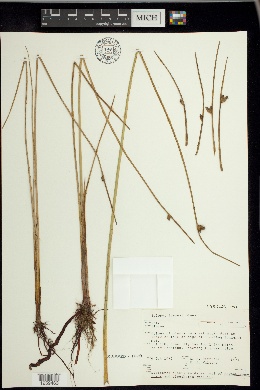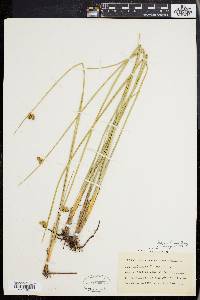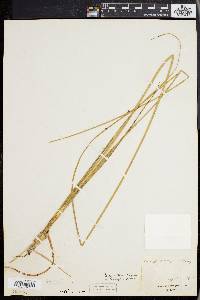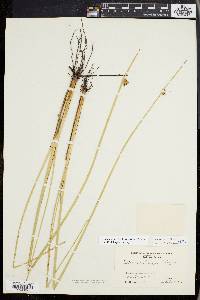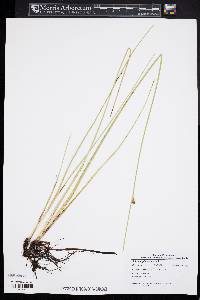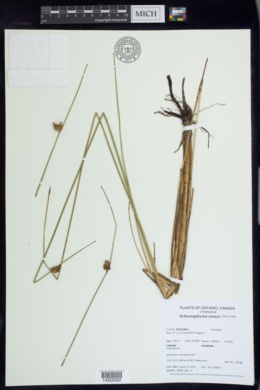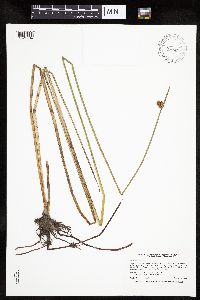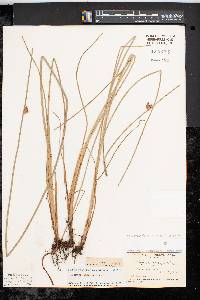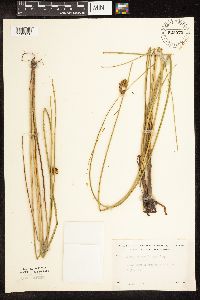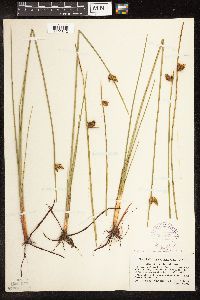Schoenoplectus torreyi
|
|
|
|
Family: Cyperaceae
Torrey's Wood Club-Rush, more...Torrey’s three-square bulrush
[Scirpus torreyi Olney] |
Plants mat-forming; rhizomes 1-3 mm diam. Culms sharply trigonous, sides concave distally, 0.4-1.5 m × 1.5-5 mm. Leaves 4-7, nearly equaling culm; sheath fronts delicately pinnate-fibrillose; blades 3-6, erect, the distal mostly longer than sheath, 1-2 mm, wide, proximally thickly V-shaped central region trigonous-channeled to laterally flattened, apically asymmetically laterally flattened-trigonous; apex often markedly eccentric, glabrous, smooth or angles papillose. Inflorescences capitate or 1 spikelet; proximal bract erect, resembling leaf blade, 3-20 cm. Spikelets 1-4, 7-18 × 3-5 mm; scales straw-colored to orange-brown or central region greenish, ovate-lanceolate, 4-5 × 2.5 mm, margins entire, smooth or awn sparsely spinulose, sometimes distally ciliolate at 40X, apex acute, mucronate, mucro 0.2-0.5 mm. Flowers: perianth members 6, brown, bristlelike, equaling to slightly exceeding achene, spinulose; anthers 2-3 mm; styles 3-fid. Achenes brown, compressed trigonous, ovoid to obovoid, 3.5-4.5 × 1.7-2 mm; beak 0.5-1 mm. 2n = 70. Fruiting summer. Emergent in fresh ponds and marshes, often with fluctuating water levels; 10-200 m; Man., N.B., Ont., Que.; Conn., Del., Ill., Ind., Iowa, Ky., Maine, Mass., Mich., Minn., Mo., N.H., N.J., N.Y., Ohio, Pa., R.I., Vt., Va., Wis. Schoenoplectus torreyi is very locally distributed, and probably has been extirpated from many historic localities. A specimen from an uncertain locality in Kentucky was collected in 1830. I have not seen specimens from North Dakota, South Dakota, or Nebraska. Scirpus torreyi was placed in synonymy under S. subterminalis Torrey var. cylindricus (Torrey) T. Koyama [misapplied, = Bolboschoenus novae-angliae by T. Koyama (1962b)].
Perennial herb with 1 - 3 mm wide rhizomes, mat-forming 40 cm - 1.5 m tall Leaves: basal, four to seven, nearly as long as culm. Sheath fronts bearing delicate pinnate fibers. Ligules membranous. Blades three to six, upright, upper ones usually longer than sheath, 1 - 2 mm wide, thickly V-shaped in cross-section basally, three-sided and channeled to laterally flattened centrally, asymmetrically laterally flattened and three-sided near the apex. Inflorescence: composed of one to four spikelets, terminal, subtended by bracts. Lowest bract leaf-like, upright, 3 - 20 cm long. Flowers: minute, subtended by a floral scale, lacking sepals and petals, bearing six bristles. Bristles brown, equal to or slightly longer than achene, strap-like, bearing small spines. Stamens three, exserted. Anthers 2 - 3 mm long. Pistil one. Style linear, three-cleft. Fruit: a one-seeded achene, brown, 3.5 - 4.5 mm long (including beak), to 2 mm wide, egg-shaped to reverse egg-shaped, beaked, compressed three-sided. Culm: upright, 40 cm - 1.5 m long, 1.5 - 5 mm wide, sharply three-sided (sides concave towards the apex), solid, internally spongy with air cavities. Spikelets: solitary or in clusters, 7 - 18 mm long, 3 - 5 mm wide, circular in cross-section, with eight or more floral scales. Floral scales spirally arranged, orangish brown to straw-colored, sometimes greenish down the middle, 4 - 5 mm long, 2.5 mm wide, egg- lance-shaped with a pointed apex which bears a tiny point, awned. Similar species: No information at this time. Flowering: late June to mid-August Habitat and ecology: Rare in the Chicago Region. Found on moist sandy shores in Indiana. Occurence in the Chicago region: native Etymology: Schoenoplectus comes from the Greek words schoinos, meaning rush or reed, and plectos, meaning twisted, plaited, or woven, referring to the use of the culms for making useful objects. Torreyi is named after John Torrey (1796-1873). Author: The Morton Arboretum Colonial perennial from soft rhizomes; stems erect, 5-10 dm, sharply 3-angled; lvs several, elongate, often surpassing the culm; bract erect, like a continuation
of the culm, 6-15 cm, blunt; spikes 1-4 in a head, light brown, ovoid, 8-15 mm; scales ovate, the greenish midrib excurrent as a short (to 0.5 mm) mucro beyond the tapering or minutely notched body; bristles longer than the achene; style trifid; achene compressed-trigonous, obovoid, 3.2-4 mm including the prominent (0.5+ mm) apiculus; 2n=42, 70. Marshes, muddy shores, and quiet water; N.B. to Man., s. to N.J., Pa., Va. (mts.), Ind., Mo., and Nebr. Fr July-Sept. (Schoenoplectus t.) Gleason, Henry A. & Cronquist, Arthur J. 1991. Manual of vascular plants of northeastern United States and adjacent Canada. lxxv + 910 pp. ©The New York Botanical Garden. All rights reserved. Used by permission. From Flora of Indiana (1940) by Charles C. Deam Very local in a few swamps of the northwestern part of the state. …… Indiana Coefficient of Conservatism: C = 10 Wetland Indicator Status: OBL |

